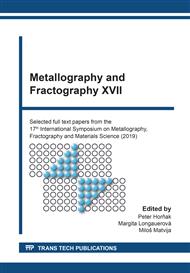[1]
X. Wei, R. Georgescu, N. Ali, I. Morjan, T.A. George, F. Dumitrache, R. Birjega, M. Chipara, R. Skomski, D.J. Sellmyer, On the Synthesis and Physical Properties of Iron-Doped SnO2 Nanoparticles, J. Nanosci. Nanotechnol. 12 (2012) 9299-9301.
DOI: 10.1166/jnn.2012.6784
Google Scholar
[2]
F. Mueller, D. Bresser, V.S.K. Chakravadhanula, S. Passerini, Fe-doped SnO2 nanoparticles as new high capacity anode material for secondary lithium-ion batteries, J. Power Sources 299 (2015) 398-402.
DOI: 10.1016/j.jpowsour.2015.08.018
Google Scholar
[3]
O.K. Varghese, C.A. Grimes, Metal oxide nanoarchitectures for environmental sensing, J. Nanosci.Nanotechnol. 3 (2003) 277-293.
DOI: 10.1166/jnn.2003.158
Google Scholar
[4]
S. Kuchibhatla, A.S. Karakoti, D. Bera, et al., One-dimensional nanostructured materials, Prog. Mater. Sci. 52 (2007) 699-913.
DOI: 10.1016/j.pmatsci.2006.08.001
Google Scholar
[5]
H. Wu, W. Pan, D. Lin, H. Li, Electrospinning of ceramic nanofibers: Fabrication, assembly and applications, J. Adv. Ceram. 1 (2012) 2-23.
DOI: 10.1007/s40145-012-0002-4
Google Scholar
[6]
R. Ramaseshan, S. Sundarrajan, R. Jose, Nanostructured ceramics by electrospinning. J. Appl. Phys. 102 (2007) 111101-111117.
DOI: 10.1063/1.2815499
Google Scholar
[7]
X. Xia, X.J. Dong, Q.F. Wei, Y.B. Cai, K.Y. Lu, Formation mechanism of porous hollow SnO2 nanofibers prepared by one-step electrospinning, Express Polym. Lett. 6 (2012) 169-176.
DOI: 10.3144/expresspolymlett.2012.18
Google Scholar
[8]
N. Haddad, Z. Ben Ayadi, H. Mahdhi, K. Djessas, Influence of fluorine doping on the microstructure, optical and electrical properties of SnO2 nanoparticles, J. Mater. Sci.: Mater. Electron. 28 (2017) 15457-15465.
DOI: 10.1007/s10854-017-7433-1
Google Scholar
[9]
A. F. Shihada, A. S. Abushamleh, F. Weller, Crystal Structures and Raman Spectra of cis-[SnCl4(H2O)2]·2H2O,cis-[SnCl4(H2O)2]·3H2O,[Sn2Cl6(OH)2(H2O)2]·4H2O, and [HL][SnCl5 (H2O)]·2.5H2O(L3-acetyl-5-benzyl-1-phenyl-4,5-dihydro-1,2,4-triazine-6-oneoxime, C18H18N4 O2), Z. Anorg. Allg. Chem. 630 (2004) 841-847.
DOI: 10.1002/zaac.200400007
Google Scholar
[10]
S. Haya, O. Brahmia, O. Halimi, M. Sebais, B. Boudine, Sol-gel synthesis of Sr-doped SnO2 thin films and their photocatalytic properties, Mater. Res. Express 4 (2017) 106406.
DOI: 10.1088/2053-1591/aa8deb
Google Scholar
[11]
P.G. Li, M. Lei, W.H. Tang, X. Guo, X. Wang, Facile route to straight SnO2 nanowires and their optical properties, Journal of Alloys and Compounds 477 (2009) 515-518.
DOI: 10.1016/j.jallcom.2008.10.130
Google Scholar
[12]
Z.W. Chen, J.K.L. Lai, C.H. Shek, Nucleation mechanism and microstructural assessment of SnO2 nanowires prepared by pulsed laser deposition, Phys. Lett. A 345 (2005) 391-397.
DOI: 10.1016/j.physleta.2005.07.041
Google Scholar
[13]
D. Li, Y. Xia Electrospinning of nanofibers: reinventing the wheel? Adv. Mater. 16 (2004) 1151-1170.
DOI: 10.1002/adma.200400719
Google Scholar
[14]
W. Wang, J. Zhou, S. Zhang, J. Song, H. Duan, M. Zhou, C. Gong, Z. Bao, B. Lu, X. Li, W. Lan, E. Xie, A novel method to fabricate silica nanotubes based on phase separation effect, J. Mater. Chem. 20 (2010) 9068-9072.
DOI: 10.1039/c0jm02120b
Google Scholar


